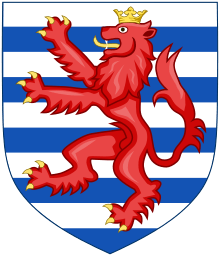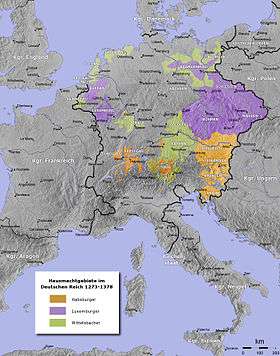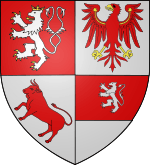Limburg-Luxemburg dynasty
The Limburg-Luxemburg dynasty, one of several families from different periods known as the Luxembourg dynasty (French: Maison de Luxembourg; German: Haus Luxemburg) was a royal family of the Holy Roman Empire in the Late Middle Ages, whose members between 1308 and 1437 ruled as King of the Romans and Holy Roman Emperors as well as Kings of Bohemia (Čeští králové, König von Böhmen) and Hungary. Their rule was twice interrupted by the rival House of Wittelsbach.
| House of Luxembourg Maison de Luxembourg | |
|---|---|
| Royal family | |
 | |
| Parent family | House of Ardennes |
| Country |
|
| Founded | 12 February 1247 |
| Founder | Henry V, Count of Luxembourg |
| Current head | None; extinct |
| Final ruler | Elizabeth of Luxembourg |
| Titles |
Others
|
| Distinctions | Order of the Dragon |
| Dissolution | 2 August 1451 |
| Deposition | 1443 |
| Cadet branches | Luxembourg-Brienne (extinct in 1648) |
History



The Luxembourg line was initially a cadet branch of the Lotharingian ducal House of Limburg–Arlon, who were in turn a branch of the Luxembourg branch of the so-called House of Ardenne. In 1247 Henry, younger son of Duke Waleran III of Limburg inherited the County of Luxembourg upon the death of his mother Countess Ermesinde, a scion of the House of Namur. Her father, Count Henry IV of Luxembourg, was related on his mother's side to the Ardennes-Verdun dynasty (also called the elder House of Luxembourg), which had ruled the county since the late 10th century.

Count Henry V's grandson Henry VII, Count of Luxembourg upon the death of his father Henry VI at the 1288 Battle of Worringen, was elected Rex Romanorum in 1308. The election was necessary after the Habsburg king Albert I of Germany had been murdered, and Henry, backed by his brother Archbishop-Elector Baldwin of Trier, prevailed against Charles, Count of Valois. Henry arranged the marriage of his son John with the Přemyslid heiress Elisabeth of Bohemia in 1310, through whom the House of Luxembourg acquired the Kingdom of Bohemia, enabling that family to compete more effectively for power with the Habsburg and Wittelsbach dynasties. One year after being crowned Holy Roman Emperor at Rome, Henry VII, still on campaign in Italy, died in 1313.
The prince-electors, perturbed by the rise of the Luxembourgs, disregarded the claims raised by Henry's heir King John, and the rule over the Empire was assumed by the Wittelsbach duke Louis of Bavaria. John instead concentrated on securing his rule in Bohemia and gradually vassalized the Piast dukes of adjacent Silesia from 1327 until 1335. His son Charles IV, in 1346 mounted the Imperial throne. His Golden Bull of 1356 served as a constitution of the Empire for centuries. Charles not only acquired the duchies of Brabant and Limburg in the west, but also the former March of Lusatia and even the Margraviate of Brandenburg in 1373 under the Kingdom of Bohemia.
The family's decline began under Charles' son King Wenceslaus, deposed by the prince-electors in 1400 who chose the Wittelsbach Elector Palatine Rupert. In 1410 rule was assumed by Wenceslaus' brother Sigismund, who once again stabilized the rule of the Luxembourgs and even contributed to end the Western Schism in 1417; however, with his death in 1437, the senior branch of the dynasty became extinct. He was succeeded by his son-in-law, the Habsburg archduke Albert V of Austria. The Habsburgs finally prevailed as Luxembourg heirs, ruling the Empire until the extinction of their senior branch upon the death of Maria Theresa in 1780.
Notable members

- Henry VII (1275–1313) – elected King of the Romans in 1308 succeeding assassinated Albert of Habsburg, crowned Holy Roman Emperor in 1312. He was succeeded by Louis IV from the House of Wittelsbach.
- Baldwin – brother of Henry, Prince-Archbishop of Trier and thereby Archchancellor of Burgundy 1307–1354.
- John the Blind (1296–1346) – only son of Henry. He was enfeoffed with Bohemia by his father in 1310, married the Přemyslid heiress Elisabeth of Bohemia and deposed the Bohemian king Henry the Carinthian.
- Charles IV (1316–1378) — eldest son of John. He was elected King of the Romans in opposition to Louis IV in 1346 and succeeded his father as king of Bohemia in the same year, crowned Holy Roman Emperor in 1355.
- John Henry, Margrave of Moravia – younger brother of Charles. He married Margaret, Countess of Tyrol, daughter of Henry the Carinthian in 1330.
- Jobst of Moravia (1351–1411) – eldest son of John Henry. Margrave of Brandenburg 1388–1411, elected King of the Romans in 1410.
- John Henry, Margrave of Moravia – younger brother of Charles. He married Margaret, Countess of Tyrol, daughter of Henry the Carinthian in 1330.
- Wenceslaus (1361–1419) – eldest surviving son of Charles. As Margrave of Brandenburg from 1373 to 1378, he was elected King of the Romans in 1376 and succeeded his father as King of Bohemia in 1378. Declared deposed by the prince-electors in 1400, he was succeeded by Rupert of Wittelsbach.
- Sigismund (1368–1437) – younger son of Charles. Margrave of Brandenburg from 1378 to 1388, he was King of Hungary from 1387 in right of his wife Mary of Anjou, and was elected King of the Romans in 1411,[1] succeeding his brother as King of Bohemia in 1419, being crowned Holy Roman Emperor in 1433 yet he left no male heirs.
- Jacquetta of Luxembourg (1415/1416–1472) – Mother of Queen Consort, Elizabeth Woodville and subsequent ancestress of all English and British monarchs since Henry VIII.
- Elizabeth of Luxembourg, only child of Emperor Sigismund, married Archduke Albert V of Austria from the Albertinian line of the House of Habsburg in 1422, becoming queen consort of Hungary from 1437 as well as Queen of the Romans and queen consort of Bohemia from 1438 until Albert's death in 1439: she was the heiress who conveyed the major portion of the Luxembourg inheritance to the Habsburgs and, later, the Jagiellons through her daughter Elisabeth of Austria.
According to the Salic law, the succession could have been disputed, in which case it would have passed collaterally to the cadet branch of Ligny. That branch descended from a younger son of Henry V, and was headed by Louis de Luxembourg, Count of Saint-Pol, before he was executed for treason by Louis XI of France.[2] This branch of Ligny ended with Marguerite de Luxembourg, Duchess of Piney, who died in 1680, last member of the House of Luxemburg. Her descendants, the Montmorency used the title of Duke of Piney-Luxembourg until 1878.
Genealogy
House of Limburg–Arlon
Having succeeded to the county of Luxemburg, the younger branch of the House of Limburg-Arlon is the family that succeeded in getting one of its scions elected Holy Roman Emperor. From there descended the Kings of Bohemia, several other Emperors and a King of Hungary as shown below.
| House of Limburg–Arlon/the House of Luxemburg | |||||||||||||||||||||||||||||||||||||||||||||||||||||||||||||||||||||||||||||||||||||||||||||||||||||||||||||||||||||||||||||||||||||||||||||||||||||||||||||||||||||||||||||||||||||||||||||||||||||||||||||||||||||||||||||||||||||||||||||||||||||||||||||||||||||||||||||||||||||||||||||||||||||||||||||||||||||||||||||||||||||||||||||||||||||||||||||||||||||||||||||||||||||||||||||||||||||||||||||||||||||||||||||||||||||||||||||||||||||||||||||||||||||||||||||||||||||||||||||||||||||||||||||||||||||||||||||||||||||||||||||||||||||||||||||||||||||||||||||||||||||||||||||||||||||||||||||||||||||||||||||||||||||||||||||||||||||||||||||||||||||||||||||||||||||||||||||||||||||||||||||||||||||||||||||||||||||||||||||||||||||||||||||||||||||||||||||||||||||||||||||||||||||||||||||||||||||||||||||||||||||||||||||||||||||||||||||||||||||||||||||||||||||||||||||||||||||||||||||||||||||||||||||||||||||||||||||||||||||||||||||||||||||||||||||||||||||||||||||||||||||||||||||||||||||||||||||||||||||||
|---|---|---|---|---|---|---|---|---|---|---|---|---|---|---|---|---|---|---|---|---|---|---|---|---|---|---|---|---|---|---|---|---|---|---|---|---|---|---|---|---|---|---|---|---|---|---|---|---|---|---|---|---|---|---|---|---|---|---|---|---|---|---|---|---|---|---|---|---|---|---|---|---|---|---|---|---|---|---|---|---|---|---|---|---|---|---|---|---|---|---|---|---|---|---|---|---|---|---|---|---|---|---|---|---|---|---|---|---|---|---|---|---|---|---|---|---|---|---|---|---|---|---|---|---|---|---|---|---|---|---|---|---|---|---|---|---|---|---|---|---|---|---|---|---|---|---|---|---|---|---|---|---|---|---|---|---|---|---|---|---|---|---|---|---|---|---|---|---|---|---|---|---|---|---|---|---|---|---|---|---|---|---|---|---|---|---|---|---|---|---|---|---|---|---|---|---|---|---|---|---|---|---|---|---|---|---|---|---|---|---|---|---|---|---|---|---|---|---|---|---|---|---|---|---|---|---|---|---|---|---|---|---|---|---|---|---|---|---|---|---|---|---|---|---|---|---|---|---|---|---|---|---|---|---|---|---|---|---|---|---|---|---|---|---|---|---|---|---|---|---|---|---|---|---|---|---|---|---|---|---|---|---|---|---|---|---|---|---|---|---|---|---|---|---|---|---|---|---|---|---|---|---|---|---|---|---|---|---|---|---|---|---|---|---|---|---|---|---|---|---|---|---|---|---|---|---|---|---|---|---|---|---|---|---|---|---|---|---|---|---|---|---|---|---|---|---|---|---|---|---|---|---|---|---|---|---|---|---|---|---|---|---|---|---|---|---|---|---|---|---|---|---|---|---|---|---|---|---|---|---|---|---|---|---|---|---|---|---|---|---|---|---|---|---|---|---|---|---|---|---|---|---|---|---|---|---|---|---|---|---|---|---|---|---|---|---|---|---|---|---|---|---|---|---|---|---|---|---|---|---|---|---|---|---|---|---|---|---|---|---|---|---|---|---|---|---|---|---|---|---|---|---|---|---|---|---|---|---|---|---|---|---|---|---|---|---|---|---|---|---|---|---|---|---|---|---|---|---|---|---|---|---|---|---|---|---|---|---|---|---|---|---|---|---|---|---|---|---|---|---|---|---|---|---|---|---|---|---|---|---|---|---|---|---|---|---|---|---|---|---|---|---|---|---|---|---|---|---|---|---|---|---|---|---|---|---|---|---|---|---|---|---|---|---|---|---|---|---|---|---|---|---|---|---|---|---|---|---|---|---|---|---|---|---|---|---|---|---|---|---|---|---|---|---|---|---|---|---|---|---|---|---|---|---|---|---|---|---|---|---|---|---|---|---|---|---|---|---|---|---|---|---|---|---|---|---|---|---|---|---|---|---|---|---|---|---|---|---|---|---|---|---|---|---|---|---|---|---|---|---|---|---|---|---|---|---|---|---|---|---|---|---|---|---|---|---|---|---|---|---|---|---|---|---|---|---|---|---|---|---|---|---|---|---|---|---|---|---|---|---|---|---|---|---|---|---|---|---|---|---|---|---|---|---|---|---|---|---|---|---|---|---|---|---|---|---|---|---|---|---|---|---|---|---|---|---|---|---|---|---|---|---|---|---|---|---|---|---|---|---|---|---|---|---|---|---|---|---|---|---|---|---|---|---|---|---|---|---|---|---|---|---|---|---|---|---|---|---|---|---|---|---|---|---|---|---|---|---|---|---|---|---|---|---|---|---|---|---|---|---|---|---|---|---|---|---|---|---|---|---|---|---|---|---|---|---|---|---|---|---|---|---|---|---|---|---|---|---|---|---|---|---|---|---|---|---|---|---|---|---|---|---|---|---|---|---|---|---|---|---|---|---|---|---|---|---|---|---|---|---|---|---|---|---|---|---|---|---|---|---|---|---|---|---|---|---|---|---|---|---|---|---|---|---|---|---|---|---|---|---|---|---|---|---|---|---|---|---|---|---|---|---|---|---|---|---|---|---|---|---|---|---|---|---|---|---|---|---|---|---|---|---|---|---|---|---|---|---|---|---|---|---|---|---|---|---|---|---|---|---|---|---|---|---|---|---|---|---|---|---|---|---|---|---|---|---|---|---|---|---|---|---|---|---|---|---|---|---|---|---|---|---|---|---|---|---|---|---|---|---|---|---|---|---|---|---|---|---|---|---|---|---|---|---|---|---|---|---|---|---|---|---|---|---|---|---|---|---|---|---|---|---|---|---|---|---|---|---|---|---|---|---|---|---|---|---|---|---|---|
| |||||||||||||||||||||||||||||||||||||||||||||||||||||||||||||||||||||||||||||||||||||||||||||||||||||||||||||||||||||||||||||||||||||||||||||||||||||||||||||||||||||||||||||||||||||||||||||||||||||||||||||||||||||||||||||||||||||||||||||||||||||||||||||||||||||||||||||||||||||||||||||||||||||||||||||||||||||||||||||||||||||||||||||||||||||||||||||||||||||||||||||||||||||||||||||||||||||||||||||||||||||||||||||||||||||||||||||||||||||||||||||||||||||||||||||||||||||||||||||||||||||||||||||||||||||||||||||||||||||||||||||||||||||||||||||||||||||||||||||||||||||||||||||||||||||||||||||||||||||||||||||||||||||||||||||||||||||||||||||||||||||||||||||||||||||||||||||||||||||||||||||||||||||||||||||||||||||||||||||||||||||||||||||||||||||||||||||||||||||||||||||||||||||||||||||||||||||||||||||||||||||||||||||||||||||||||||||||||||||||||||||||||||||||||||||||||||||||||||||||||||||||||||||||||||||||||||||||||||||||||||||||||||||||||||||||||||||||||||||||||||||||||||||||||||||||||||||||||||||||
Early Luxembourg counts/Ancestry
The House of Luxemburg/Luxembourg stemmed from the House of Ardenne (or Ardennes, French Maison d'Ardenne) which was an important medieval noble family from Lotharingia, known from at least the tenth century. They had several important branches, descended from several brothers:[3]
- The House of Ardenne-Luxembourg, descended from Count Sigfried, the ancestors of the counts of Luxemburg.
- The House of Ardenne-Verdun, with several Dukes of Lower Lotharingia, descended from Count Gozelin.
- The House of Ardenne-Bar, with several Dukes of Upper Lotharingia, descended from Frederick I, Duke of Upper Lorraine.
Two houses descended from the women of the counts of Luxembourg, the Counts of Loon and the Counts of Grandpré, which wear a shield barry. Both families had a place in relation to the succession of the House of Ardennes. Indeed, the Count of Grandpré was the next heir of Conrad II of Luxembourg, the last representative of the Ardennes dynasty, but Emperor Frederick Barbarossa preferred that Luxembourg was held by a lord Germanic rather than French and attributed the county to Henry, son of Conrad's aunt Ermesinde and Count Godfrey I of Namur. The Counts of Loon are also in position to claim the inheritance Luxembourg, albeit weaker position:
| Ancestors of the House of Luxembourg | ||||||||||||||||||||||||||||||||||||||||||||||||||||||||||||||||||||||||||||||||||||||||||||||||||||||||||||||||||||||||||||||||||||||||||||||||||||||||||||||||||||||||||||||||||||||||||||||||||||||||||||||||||||||||||||||||||||||||||||||||||||||||||||||||||||||||||||||||||||||||||||||||||||||||||||||||||||||||||||||||||||||||||||||||||||||||||||||||||||||||||||||||||||||||||||||||||||||||||||||||||||||||||||||||||||||||||||||||||||||||||||||||||||||||||||||||||||||||||||||||||||||||||||||||||||||||||||||||||||||||||||||||||||||||||||||||||||||||||||||||||||||||||||||||||||||||||||||||||||||||||||||||||||||||||||||||||||||||||||||||||||||||||||||||||||||||||||||||||||||||||||||||||||||||||
|---|---|---|---|---|---|---|---|---|---|---|---|---|---|---|---|---|---|---|---|---|---|---|---|---|---|---|---|---|---|---|---|---|---|---|---|---|---|---|---|---|---|---|---|---|---|---|---|---|---|---|---|---|---|---|---|---|---|---|---|---|---|---|---|---|---|---|---|---|---|---|---|---|---|---|---|---|---|---|---|---|---|---|---|---|---|---|---|---|---|---|---|---|---|---|---|---|---|---|---|---|---|---|---|---|---|---|---|---|---|---|---|---|---|---|---|---|---|---|---|---|---|---|---|---|---|---|---|---|---|---|---|---|---|---|---|---|---|---|---|---|---|---|---|---|---|---|---|---|---|---|---|---|---|---|---|---|---|---|---|---|---|---|---|---|---|---|---|---|---|---|---|---|---|---|---|---|---|---|---|---|---|---|---|---|---|---|---|---|---|---|---|---|---|---|---|---|---|---|---|---|---|---|---|---|---|---|---|---|---|---|---|---|---|---|---|---|---|---|---|---|---|---|---|---|---|---|---|---|---|---|---|---|---|---|---|---|---|---|---|---|---|---|---|---|---|---|---|---|---|---|---|---|---|---|---|---|---|---|---|---|---|---|---|---|---|---|---|---|---|---|---|---|---|---|---|---|---|---|---|---|---|---|---|---|---|---|---|---|---|---|---|---|---|---|---|---|---|---|---|---|---|---|---|---|---|---|---|---|---|---|---|---|---|---|---|---|---|---|---|---|---|---|---|---|---|---|---|---|---|---|---|---|---|---|---|---|---|---|---|---|---|---|---|---|---|---|---|---|---|---|---|---|---|---|---|---|---|---|---|---|---|---|---|---|---|---|---|---|---|---|---|---|---|---|---|---|---|---|---|---|---|---|---|---|---|---|---|---|---|---|---|---|---|---|---|---|---|---|---|---|---|---|---|---|---|---|---|---|---|---|---|---|---|---|---|---|---|---|---|---|---|---|---|---|---|---|---|---|---|---|---|---|---|---|---|---|---|---|---|---|---|---|---|---|---|---|---|---|---|---|---|---|---|---|---|---|---|---|---|---|---|---|---|---|---|---|---|---|---|---|---|---|---|---|---|---|---|---|---|---|---|---|---|---|---|---|---|---|---|---|---|---|---|---|---|---|---|---|---|---|---|---|---|---|---|---|---|---|---|---|---|---|---|---|---|---|---|---|---|---|---|---|---|---|---|---|---|---|---|---|---|---|---|---|---|---|---|---|---|---|---|---|---|---|---|---|---|---|---|---|---|---|---|---|---|---|---|---|---|---|---|---|---|---|---|---|---|---|---|---|---|---|---|---|---|---|---|---|---|---|---|---|---|---|---|---|---|---|---|---|---|---|---|---|---|---|---|---|---|---|---|---|---|---|---|---|---|---|---|---|---|---|---|---|---|---|---|---|---|---|---|---|---|---|---|---|---|---|---|---|---|---|---|---|---|---|---|---|---|---|---|---|---|---|---|---|---|---|---|---|---|---|---|---|---|---|---|---|---|---|---|---|---|---|---|---|---|---|---|---|---|---|---|---|---|---|---|---|---|---|---|---|---|---|---|---|---|---|---|---|---|---|---|---|---|---|---|---|
| ||||||||||||||||||||||||||||||||||||||||||||||||||||||||||||||||||||||||||||||||||||||||||||||||||||||||||||||||||||||||||||||||||||||||||||||||||||||||||||||||||||||||||||||||||||||||||||||||||||||||||||||||||||||||||||||||||||||||||||||||||||||||||||||||||||||||||||||||||||||||||||||||||||||||||||||||||||||||||||||||||||||||||||||||||||||||||||||||||||||||||||||||||||||||||||||||||||||||||||||||||||||||||||||||||||||||||||||||||||||||||||||||||||||||||||||||||||||||||||||||||||||||||||||||||||||||||||||||||||||||||||||||||||||||||||||||||||||||||||||||||||||||||||||||||||||||||||||||||||||||||||||||||||||||||||||||||||||||||||||||||||||||||||||||||||||||||||||||||||||||||||||||||||||||||
See also
References
| Wikimedia Commons has media related to House of Luxembourg. |
- "Sigismund (Holy Roman emperor)". Encyclopædia Britannica. Retrieved 2014-03-29.
- Cave, Roy; Coulson, Herbert (1965). A Source Book for Medieval Economic History. New York: Biblo and Tannen. p. 336.
- Parisse, ‘Généalogie de la Maison d'Ardenne’, La maison d'Ardenne Xe-XIe siècles. Actes des Journées Lotharingiennes, 24 - 26 oct. 1980, Centre Univ., Luxembourg, (1981) 9-41





.svg.png)












.svg.png)
.svg.png)
.svg.png)
